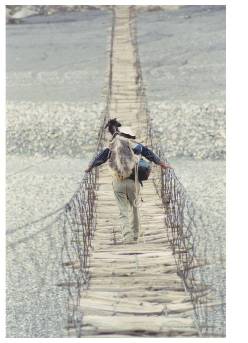Over the last four weeks, Jon Becker and I have facilitated a journey for our online students into the heretofore unknown world (for them) of Web 2.0. Our students are all K-12 teachers from three different states in our Education Technology and School Leadership course. After two weeks of typical “schoolroom” topical exploration and discussion, we gave them their first project:
Research one of the Top 100 Tools from Jane Hart‘s list and present your findings in a short multimedia tutorial presentation to the rest of your classmates.
26 students – 26 tools
In two weeks.
With no further guidance.
Two weeks ago, you might as well said: Take this goat and cross this rickety bridge. (Love this image!)
As one might imagine, during the past two weeks, these students stressed out over just how to do their projects. One noted that she was ready to toss her computer through her window! I suspect that several of them would have preferred carrying a goat over doing a web presentation! At the start of the journey, very few of these students had any experience in web applications.
This weekend, 26 presentations had been uploaded into our class wiki.
Our students reviewed each others presentations and commented in our class discussion forums about what they learned themselves and what they learned from each other. Many of the comments discussed their stresses in trying to figure out how to present online and how amazed they were that they overcame them and completed their projects on time.
My team mate Jeff Nugent passed me a relevant article this past weekend from Barbara McCombs and Donna Vakili, entitled “A Learning-Centered Framework for E-Learning.” It noted that content has become so abundant as to make it a poor foundation on which to base an education system. Rather, context and meaning are the important commodities today. My students may have started their journey assuming that the tool they were studying was the critical element, but they ended realizing that it was the journey that was important. One student noted:
“After reading these posts, it seems that we all agreed that using our tool was not the hard part of this assignment. Perhaps Britt and John knew that when making this assignment…”
I collected their reflections and dumped them into Wordle to see what emerged:
A few things jumped out at me.
USE – Most felt that they would use these tools (and several presented by their classmates) in their teaching.
JING – Jing became the default method for presenting their respective tools to each other. It was not the only method, however. We also had some Camtasia screencasts, some YouTube videos, an iMovie clip, and one engaging seaturtle with Blabberize.
STUDENTS and LEARNING – while each of these graduate students approached their specific tool in unique ways, they all focused in on the educational implications of web applications. Many stated this was eye-opening for them.
And finally, TIME – they recognized the time investments one must make to gain proficiency with these tools.
I found one student’s comment particularly revealing:
“I had been dreading the actual tutorial because the technology scared me to death! Once I played around with Jing, and saw how easy it was, it wasn’t so bad after all. I learned that I definitely have some fears when it comes to technology! It made me wonder why I have them. My students definitely don’t. My 11 year old doesn’t. They just dive in and play with it until they know it. I wondered when I lost that in myself…”
Another lesson that several reflected on was how this project reflected the social nature of web learning. In keeping with the theme from this year’s EduCon, Jon and I had reinforced the notion that all learning can and should be networked learning, and that they should therefore support one another as they developed their presentations. They found this support one of the most valuable aspects of the project.
The McCombs/Vakili article noted that research “underlying the learner-centered principles confirms that learning is nonlinear, recursive, continuous, complex, relational, and natural in humans” (p. 1586). The lessons learned by these students backs this up – messy at the time but rewarding when accomplished.
Four weeks ago, I told these students that they would freak out doing their projects, but that they would persevere and all complete their projects…and be amazed and proud of themselves. This weekend, they saw that I was right.
26 different destinations, but one journey – and it was fun to go along for the ride!
{Photo Credit: Jungle Boy}


![Reblog this post [with Zemanta]](http://img.zemanta.com/reblog_e.png?x-id=f6f3aed4-e162-4d9e-bb05-54b06e9f77d0)